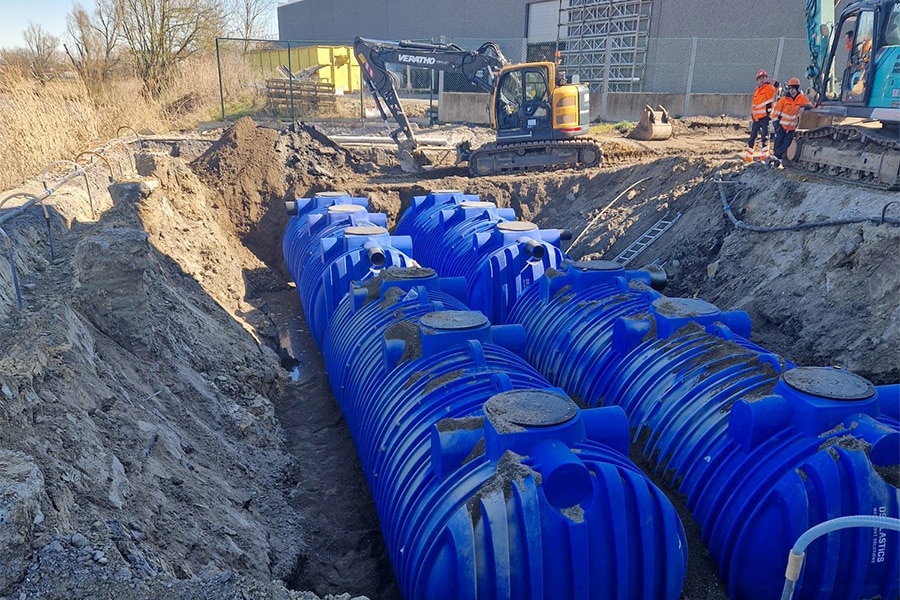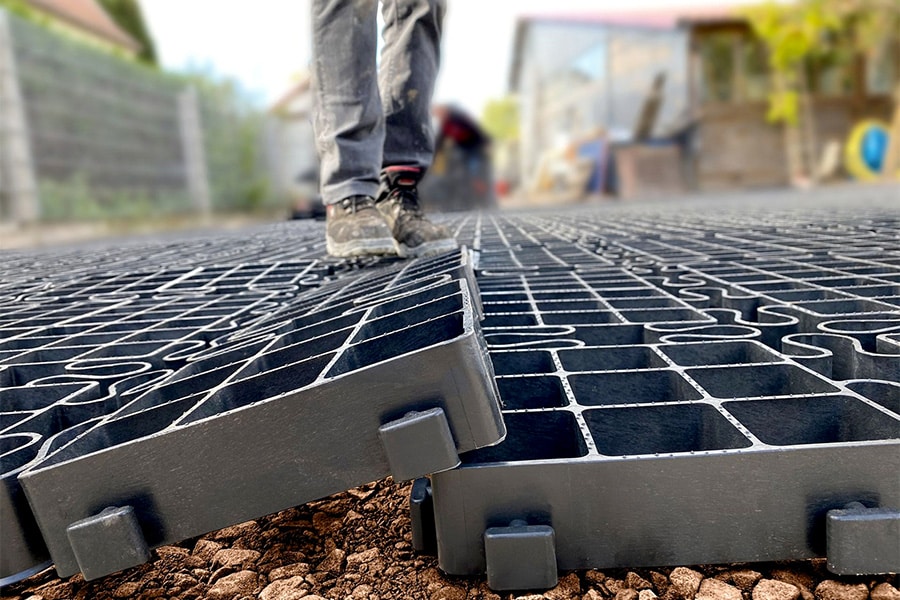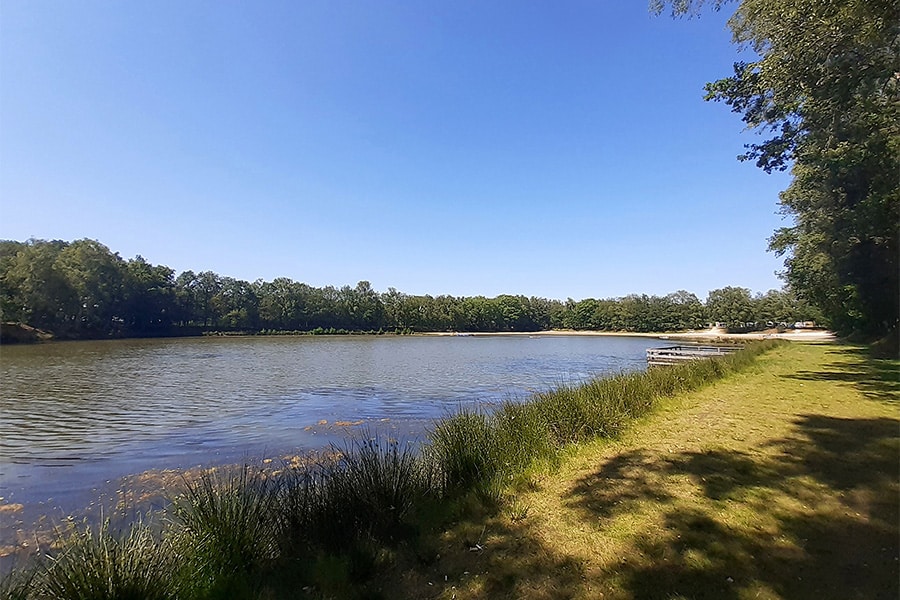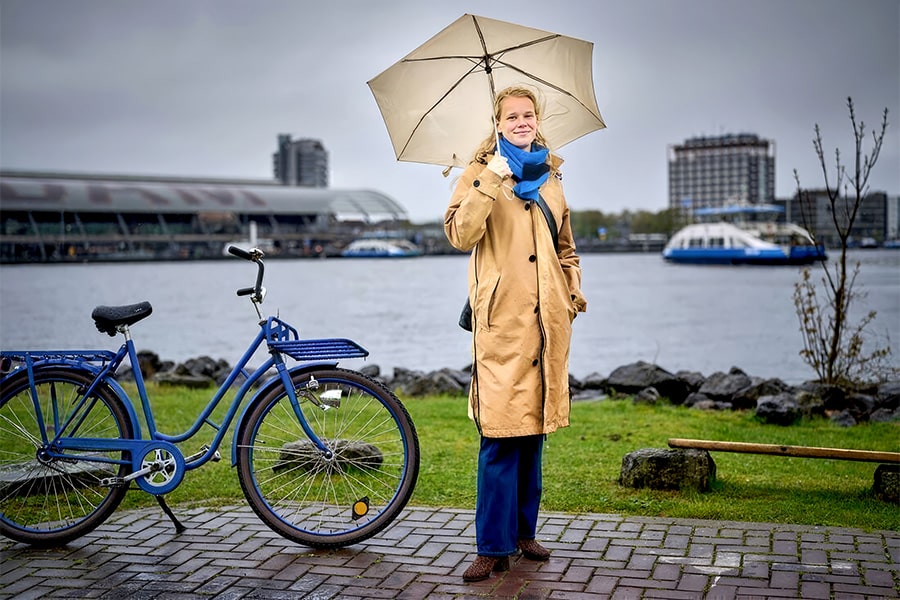
Sustainable and packed with innovations. Reconstruction N395 Hilvarenbeek - Oirschot
Major road maintenance is needed about once every ten years. At that time, the province of North Brabant immediately looks at what else needs to be done. In the case of the provincial road N395, there was a need to improve safety and livability in the surrounding villages. This is why the province and BAM Infra Nederland are now working together to improve the road safety and accessibility of the N395, improve traffic flow, increase greenery and reduce noise in the villages.
And this is done in an extremely sustainable manner in which there is plenty of room for innovation. And both parties are well entrusted with that. For example, the province of North Brabant has won the award for the most sustainable public tenderer three times in a row, and last year BAM was named the most sustainable construction company.

The N395 runs straight through the municipalities of Hilvarenbeek and Oirschot over a length of about 13 kilometers and crosses no less than three village centers: Diessen, Middelbeers and Oostelbeers. A rather unique situation for a provincial road. In 2013, the N395 planning study examined how best to address the problems on the N395. "On the one hand, the road has to be accessible and safe for local residents, but on the other hand we also have to promote traffic flow," explains Jan de Kruijf, project manager for infra projects at the province of North Brabant. "We tried to reconcile these aspects as best we could and included them integrally in the further elaboration of the plan and the preparation of the contract. The environment and other stakeholders were also closely involved. Among other things, this led to a modified road design with a more village-like character in the cores, more greenery and safe crossings at various points."

Climate Goals
One of the main goals of the province of North Brabant is energy transition. The province sets the goal of generating 50% of energy sustainably by 2030. By 2050, this should be 100%. This energy transition will lead to a huge reduction in CO2-emissions, and that is necessary to
combating climate change.
"In order to meet the target, we are pulling out all the stops on all fronts," said Suzanne Otters, Deputy Commissioner for Mobility, Organization and European Programs. "In all our projects, we strive to make them as sustainable as possible. We seize opportunities wherever they arise. So too in the area of mobility and infrastructure. As soon as we know that a provincial road is due for reconstruction, we look at how we can achieve this in the most sustainable way possible. Because on the one hand we want the roads to be safe and for traffic to flow smoothly, but at the same time we want Brabant to remain livable and beautiful." The province therefore worked out a plan five years ago to make its tenders more sustainable and to approach the market in this in a uniform and consistent way. And with success. Otters: "I am impressed by the enormous leap that the province, together with the market, has made in this regard. The reconstruction of the N395 is a fine example of how we can contribute concretely to achieving the climate goals."

Attractive client
The province awards largely on quality (40-60%), half of that assessment being on sustainability. "This allows the contractor to earn a notional discount on his bid price," explains De Kruijf. "For this, the province looks in particular at the CO2-footprint and to the
risk file surrounding the sustainable innovations. In some cases, a third criterion is applied. For the N395, this was the
reduction of nitrogen deposition. And so every project has its specials. In addition, innovative solutions are encouraged, for which we provide the necessary space and flexibility." Eric van Avendonk, regional director at BAM Infra Nederland, adds: "The great thing about the collaboration like here on the N395 is that in this case the province functionally asks what the end result should be, but that we as a construction company are allowed to interpret this ourselves within the requirements and the reference design. In other words, the province challenges us to give maximum substance to the theme of sustainability. That makes the province a very attractive client."
Emission-free equipment
BAM Infra Netherlands has been committed to a sustainable living environment for many years. "The consumption of primary raw materials is an important pillar that we have a direct influence on, as are the emissions on both the construction site and in our production sites," says Van Avendonk. "We try to reduce that as much as possible. And that is reflected in reusing materials as much as possible and lowering our footprint. In addition, with our designs we try to give substance to the themes of livability, social impact and climate adaptation. We want to encourage the market to build as sustainably as possible. In doing so, we emphatically take responsibility ourselves, for example by investing in emission-free equipment and striving for an emission-free construction site. For example, we have an electric roller and we recently commissioned the world's first electric asphalt spreading machine. Equipment that we will also use during the reconstruction of the N395."

A guest in the area
The design of the new route was largely established during the planning study. De Kruijf: "We left the fine-tuning of the design and its engineering to BAM in order to achieve optimizations where possible." Van Avendonk: "We have been playing chess on several boards simultaneously since the tender in order to meet the many challenges as well as possible, taking into account the ten-year maintenance period. Those efforts eventually led to a design with the input of about five innovations, a near maximum CO2- reduction (74% compared to the reference footprint) and a plan of action based primarily on limiting nuisance and safety. Safety for the surrounding area and for our own people, whereby we reduce the inconvenience to a minimum. We are, as it were, guests in the environment and reconstruct the road instead of the other way around where the project is leading to the detriment of the environment. This combination ultimately
led to a very positive appreciation from the province of North Brabant that made us the best bidder."
Innovations
Several innovations will be used on the N395. "We have tendered with about four TRLs (Technology Readiness Level)," says Walter Pellekaan, project manager at BAM Infra Nederland. "It ranges from sustainable asphalt mixtures at the TRL5 and 7 level that have not been applied before to the Den Ouden DO 3.0 mixture and Van Velsen's Fabiola biobased road marking that have been applied before. In this way, we were able to achieve the maximum score in terms of sustainability. From the province, a fifth innovation was added in the form of a solar bike path pilot. This was fleshed out with a concept from three different suppliers." De Kruijf: "The pilot along the N395 is the prelude to a much larger project to construct many hundreds of meters of solar bike path. A project recently put out to tender in cooperation with the provinces of North and South Holland."
After the N395 tender, the province of North Brabant included another line item "innovations in sustainability. "We deliberately did not include this in the contract so as not to exclude the latest developments. After all, there are many years between drawing up the contract and its realization." Pellekaan: "That leads here, among other things, to the application of bio-based signage, a bicycle path made of geopolymer concrete and our innovative Compact Ecorail. With Compact Ecorail, the foundation is anchored at an angle. This eliminates the need to place guardrail posts on the strip where pipes are located. In the event of any collisions, damage to pipes is prevented this way."
Proud
In November 2020, the work was finally awarded to BAM Infra Nederland. On July 25, 2021, the first phase of the
reconstruction. "The project is divided into five phases and will run until the fall of 2022. We will return in the spring of 2023 to further complete the traffic circle in Oostelbeers," said Pellekaan. Meanwhile, in Hilvarenbeek the new kluif traffic circle has been constructed, between Hilvarenbeek and Diessen the intersection of the N395 with Waterstraat has been addressed. In the village center of Diessen, the traffic circle at the Meiraap and the intersections with the N395 have been adjusted. The connection to the A58 and business park the Scheper has also been improved. Pellekaan: "We deliberately chose to tackle the biggest bottlenecks (connection to the N269 and to the A58) first." And that turned out to be a good move. "The first results are encouraging. Bicycle safety has improved considerably and there is a clear improvement in traffic flow," observes De Kruijf, who is also very satisfied with the cooperation with the contractor. "We have short lines of communication with the BAM project team and that just works very pleasantly." Pellekaan can also agree: "We are proud of where we are now, especially when you consider that the project was started completely remotely in corona time and until the very last moment it was tense whether we were allowed to start at all because of the nitrogen issue. The permit was only issued a week before the start of implementation."
Van Avendonk is also proud. "We are far from finished, but so far we have jointly delivered a fine performance and have already been able to partially fulfill the intended ambitions, both to the province and to the surrounding area. In that sense, the project is also a prelude to the enormous task we are facing together.
Cooperation is crucial in this. The province of North Brabant, Bouwend Nederland and BrabantStad are making great strides in this with the INDUSA platform, an initiative to accelerate the sustainability of Brabant's infrastructure. This creates a
flywheel and you can make steps faster. If national, provincial and municipal governments all follow the same course, market parties will pick up the gauntlet to take sustainability further. You can see that effect in the results of projects, such as here on the N395.".
Sustainability at BAM
BAM Infra Nederland is building a sustainable living environment. It wants to have a positive environmental impact on its surroundings. To this end, it has been working for several years on themes such as zero-emission construction, circular construction, using renewable energy and building with as few waste streams as possible.
With a working group for each theme, BAM Infra Nederland takes initiatives to achieve its own objectives and those of its clients. Cooperation with clients and supply chain partners is crucial here.
When it comes to emission-free construction, BAM has a number of world firsts. In 2020, for example, it introduced the world's first electric roller, which reduces CO2-emissions per year. In 2021, it commissioned the world's first hybrid probe truck, which will reduce CO2-emissions by 34 tons annually. And in 2022, BAM came out with the world's first electric asphalt spreading machine, reducing 93,000 kilograms of CO2 saves on an annual basis. Some smaller equipment has also already been electrified, from rammers to excavators. In this way, BAM Infra Nederland is taking steps to ultimately achieve an emission-free construction site.



